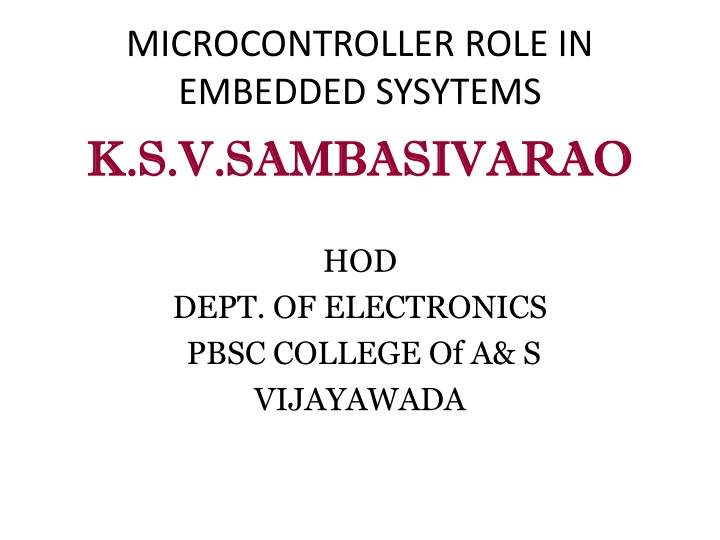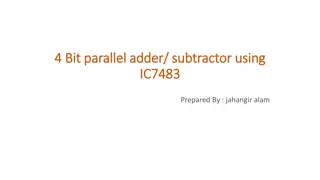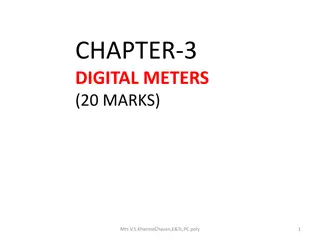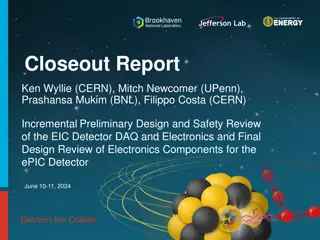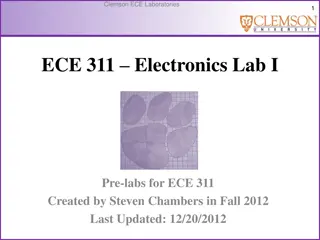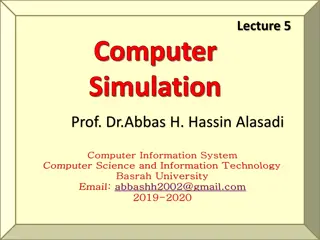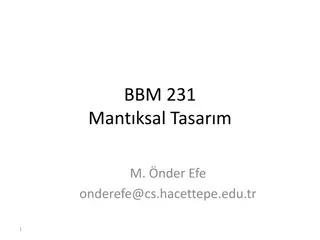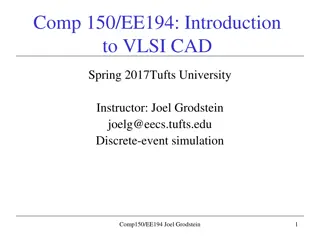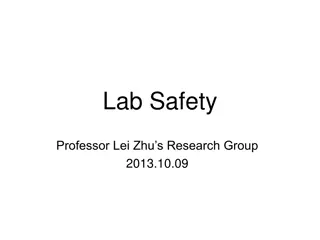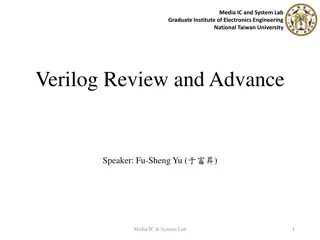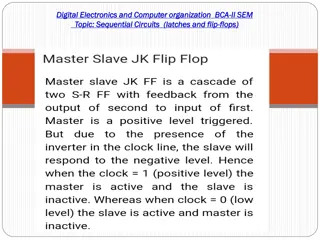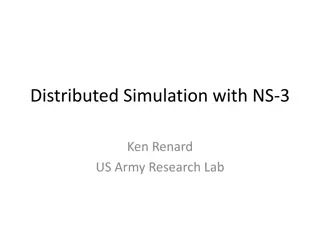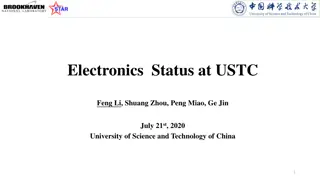Digital Electronics Lab 5: Full Subtractor Simulation
In this lab project, students will build and simulate a full subtractor using logic gates such as XOR, inverters, AND, NAND, OR, NOR, and more. The objective is to implement a 4-bit subtractor and test its functionality with specific inputs. The content includes truth tables, implementation details, schematics, symbols, test circuits, waveforms, and simulations for both the full subtractor and the 4-bit subtractor.
Download Presentation

Please find below an Image/Link to download the presentation.
The content on the website is provided AS IS for your information and personal use only. It may not be sold, licensed, or shared on other websites without obtaining consent from the author.If you encounter any issues during the download, it is possible that the publisher has removed the file from their server.
You are allowed to download the files provided on this website for personal or commercial use, subject to the condition that they are used lawfully. All files are the property of their respective owners.
The content on the website is provided AS IS for your information and personal use only. It may not be sold, licensed, or shared on other websites without obtaining consent from the author.
E N D
Presentation Transcript
MICROCONTROLLER ROLE IN EMBEDDED SYSYTEMS K.S.V.SAMBASIVARAO K.S.V.SAMBASIVARAO HOD DEPT. OF ELECTRONICS PBSC COLLEGE Of A& S VIJAYAWADA
CONTENT INTRODUCTION ARCHITECTURE TYPES TOOLS SFR ADDRESSING MODES INSTRUCTION SET
MICROCONTOLLER It is an integrated circuit that can be programmed to perform a set of functions to control collection of electronic devices Micro Controller has CPU (Micro Processor) in addition to a fixed amount of RAM, ROM, I/P-O/P PORTS and timers on a single chip. Eg: TV Remote control, Telephone, Music instruments, printer etc. Microcontroller is the heart of embedded system and mainly used in MP3player. These applications require I/P-O/P operations to read signals and turn on &off certain bits for this reason. They use processor IBP are known as ITTY-BITTY processor. It is a 40 pin dip and quad flat package (qft) and is require +5V power. In a embedded system the microprocessor and micro controller are widely used in embedded system products to do one task. Eg: Printer. It has unique instruction set and register and they are not compactable to each other and their also has 16 bit and 32 bit processor In 8031 microcontroller its having 128 bytes RAM 4K byte ROM ,32 I/P-O/P ports ,One serial port, 6 interrupt sources ,2 timers
In 1981 Intel Corporation introduce 8 bit micro controller. It s having 128 bytes RAM,4K bytes ROM,1-serial port,4- I/P and O/P ports 6- Interrupt sources, 2- timers. It has 2 versions 8052 and 8031. In 8052 its having 256 bytes RAM 8K bytes ROM,3 timers,32 I/P-O/P ports,One serial port,6 interrupt sources The program written in 8051 can run in 8052 but the vice-versa is not possible.
In 8751 micro controller the flash memory can be erased in 20 min are more whereas 8051 requires few seconds. Eg: Atmel 89C51-12PC At89C51-16PC At89C51-32PC There are 4 major companies for 8 bit micro controller are free scale 6811, Intel 8051,Zilog 8051,PIC 16X. The 8051 Phillips company feature are A/D, D/A extended for I/P-O/P port on time programmable (OTP) and flash. Since memory and I/O connected internally the circuit becomes small. It has more number of registers hence programme is easier to write. Microcontroller having power saving modes like idle & power saving mode. It s clock speed is high i.e(1GHZ) It used in Real time applications.
Architecture of 8051 It was developed by using NMOS technology but these require more power to operate then Intel re-design micro controller using CMOS technology. it supports von-neuman and Princeton architecture. -single data bus for fetch both instruction and data, Hardvard-separate data bus and instruction bus. It is an 8-bit B register to perform arithmetic and logic operations. DPTR (Data pointer) : is used for control the program instruction and can specified by its 16-bits. The 8051 have a built in RAM for internal processing. This memory is primary memory and is used for storage of temporary data (volatile memory) i.e., it contains gets vanish when power is turned off. CPU: CPU is the brain of processing device. It monitors and controls all operations that all perform in micro controller. INTERRUPTS: It is a sub routine device call that interrupts micro controller main operation or work causes it to execute some other program which is more important at that time. The feature of interrupt is very useful as it help in cases of emergency. There are 5 interrupt sources, 2 of them are external and 3 of them are internal interrupts.
MEMORY: Memory is a storage device to store data. It is used to store the program of micro controller is known as code memory or program memory (ROM). It is used to store data or operands temporarily then it is known as data memory(RAM). it is of two types (i)Embedded-All functional blocks on a chip(ii)External-it does not have functional blocks on chip. BUS: It is a collection of wires which work as a communicate channel or medium to transfer the data. The bus consists of 8 or 16 wires. Address Bus: It is a uni-directional (16 bit).It transfer data from CPU to memory(A0-A7). Data Bus: It is a bi-directional (8 bit).It carry data from cpu to memory vice- verssa(D0-D7). Control bus: It controls the clock frequency between AB&DB.
OSCILLATOR: It is used to generate clock pulse to synchronize all internal operations. It generates frequency range from minimum to maximum (1MHz-12MHz). Generally quartz crystals are used for stability(11.0592MHZ) whereas ceramic oscillators are unstable. PROGRAM STATUS WORD (PS w): It is a 8-bit register referred as flag register. psw.7 psw.6 psw.5 psw.4 psw.3 psw.2 psw.1 psw.0 In this 6 bits used in 8051 and 2 bits are user definable flags and 4 flags are conditional flags. Carry Flag: This flag is set whenever there is a carry out from D7bit.It can directly set to 1 or 0 by using SET C-1, CLR c-0(addition, subtraction). Auxiliary Carry Flag: If there is a carry from D3to D4during addition or subtraction operation, This bit is set or clear (BCD operation). Parity Carry Flag: 1. It reflects no. of 1 s in accumulator register only. 2.If A register contains odd no. of 1 s then p=1.
Timer-Counters: intervals to determine pulse width etc. I/P-O/P ports: It has 4 ports port 0,1,2,3.Each port is 8 bit wide. It is used in embedded systems to control the operation of SYSTEMS It has two 16 timers and counters .The timers are used for measurement of
Types of Micro-Controller Micro controller is classified into 4 types depending on memory, architecture and instruction set. They are 4 bit: It is small in size, minimum pin count, low cost and it is used in low end applications like LED, LCD, display drivers and portable battery charges etc. It is a 20 pin dip with 4K ROM,256 bytes RAM, 14 I/O pins,2 counters. Its Intel family is RENASA 34501.ATAM862 8 bit: It is most popular micro controller. Above 55% CPU s sold in world are 8 bit micro controllers. It has 8 bit internal bus 256 bytes RAM,4K ROM, 32 bit I/O ports, 2 timers/counters and its Intel family is 8051. Intel family designs a micro controller in the year 1981.MC65HC11 FAMILY 16 bit: It has 16 bit ALU at an instruction. It is suitable for high languages like C++ and its Intel family is 8096. MC68332 FAMILIES 32 bit: It has 32 bit internal bus and is used in high end applications like robotics, communication networks, cell phones etc. Eg: PIC 32,ARM 7,and ARM 9.80960 FAMILY.
Micro controller development tools: The various development tools are required for microcontroller programming. Editor: An editor is a program which allows to create a file containing the assemble language statements for the program. Eg: As he writes the program the editor stores the ASCII codes for the letters and numbers in successive RAM location. After typing the entire program we have to save the program this we call it as source file. The next step is to process the source file with an assembler. Ex: sample.asm. Assembler: An assembler is used to translate to assemble language mnemonics into machine language(binary code) when we run the assembler it reads the source file of your program where we have saved it. The assembler generates a file with an extension .hex (hex decimal codes).
It converts a high level program like C into binary or machine codes. Eg: Kiel, Ride, IAR work bench or popular. Debugger: 1)A debugger is a program which allows stopping the program for each instruction then it is known as single step debug(static). 2)A debugger allows to set a break point in the program the debugger will run the program up to the instruction where the break point is given then it stop the execution. Hence it known as break point debug(dynamic). Eg: 10 instructions, 20 instructions ..
Special function registers There are 21 SFR used in micro controller 8051. This includes register A, register B, PSW, PCON etc. There are 21unique locations each of these register is one byte size. Sum of this SFR are bit addressable(which means we can access individual bits inside a single bit) while some other are byte addressable. Accumulator: The accumulator holds the result of both for arithmetic and logic operations. It is an 8 bit byte. Accumulator is usually accessed by direct addressing and it physical address is E0H. Accumulator is both bit and byte addressable. B-Register: The major product of register executing its MUL and DIV. In 8051 the multiplication is done by repeat subtraction. It is used for general purpose operation for both bit and byte address and physical address is F0H.
Port Register: It having 4 I/O ports named as P0,P1,P2,P3. Data must written in port registers must be first to send it out any other external devices through ports. All 4 ports are bit and byte address. Po-80,P1-90,P2-A0,P3-B0 Stack Pointer: It is an 8 bit register the direct address of stack pointer is 81H. It is only byte addressable. Stack pointer having two instructions PUSH&POP( LIFO). In PUSH the stack pointer is used to increment by 2(SP+2). In Pop the stack pointer is used to decrement by 2(Sp-2). PCON(Power Management Register): We can see every day it is used in mobile phones. It is commonly referred as Power management alone. It has 2 modes-ideal mode, power down mode.
PIN DIAGRAM 8051 family members are 8751,89C51,89C52,DS89CX40(all belongs to Intel). Its available packages are DIP, QFP, LLC(lead less carries). They are all having 40 pins. . Majority of developers use 40 pin dip. The pins are designated as VCC, GND, XTAL2, XTAL1, EA, PSEN, ALE are used by all members of 8051 and 8031 families. It is a 40 pin dip provides a supply voltage to the chip is +5V. 8051 is a chip oscillator but requires an external clock to run it. Most often we use Quartz crystal rather than TTL Oscillator. It also needs 2 capacitors 30pf values. One side of each capacitor value is connected ground. RST(Reset pin): It is a input pin , active high (normally low). It is often referred as power on reset by activating this pin it will set the program counter to all 0 s.
EA(External Access): In 8051 family members all come with one chip ROM to store program. In such case EA connected to ground or VCC. It cannot be left unconnected. PSEN(Program stored Enable): In 8031 or 8051 micro controller systems in which external ROM holds the program code. ALE(Address latch enable pin): It is an output pin and active high. It can MUX both address and data through port 0 to save pins. It is used for de-multiplexing the address and data by connecting to the chip 4LS373 chip.
PORTS Port 0: If ALE=0 it provides data D0to D7when ALE=1 it has address A0to A7. Port 0 provides both address and data. It also designated as AD0to AD7. In 8051 there is no external memory connection the pins of port 0 are connected to pull-up resistor(10K ). Port 1&2: Port 1 & 2 acts as simple I/O. In 8051 or 8031 basic system port 2 must be used along with port 0 to provide 16 bit address. P2 designated as A8to A15&p0 designated as-A0-A7.For p1,p2and p3 does not required external pull-up resistors because they connected internally. Port 3: Its pins are 10 to 17. It can be used as input (or) output. It has addition function providing some external important systems such as interrupts. It having 32 bit I/O ports and each port is 8 bit wide.
MEMORY ORGANIZATION It is divided into 2 types and there are 1.Program Memory 2.Data Memory. Program memory is used for permanent saving the program being executed. Data Memory is used for temporarily storing data(register). In program memory is read only memory (ROM). Depending on setting made in compiler and also store a constant variable. 8051 allows external program memory to be added. Microcontroller handle external memory depends on EA logic state. If EA=0,the external ROM memory is 64K. If EA=1 the additional ROM memory 64K+4K embedded memory. Internal Memory: Up to 256 bytes of internal data memory are available in 8051. The first 128 bytes of internal memory are both direct and indirect addressable. The upper 128 bytes of data memory is 0X80 to 0XFF can be addressed only indirectly. The memory block is in the range of 20H to 2FH is bit addressable which means each bit mean where has its own address from 0 to 7FH. Since there are 16 registers the block contains total of 128 bits with separate address. In this 3 memory type specifies is used to refer the internal data memory data, idata, bdata.
External data memory: It is slower than internal data memory and made up of 64K bytes of external data memory setting of the registers must be manually done in code, before any access to external memory (or) X-RAM space is made. It has two specifies i.e X- data, P-data
ADDRESSING MODES In this section, we will see different addressing modes of the 8051 microcontrollers. In 8051 there are 1-byte, 2-byte instructions and very few 3-byte instructions are present. The op-codes are 8-bit long. As the op codes are 8-bit data, there are 256 possibilities. Among 256, 255 op-codes are implemented. The clock frequency is12MHz, so 64 instruction types are executed in just 1 s, and rest are just 2 s. The Multiplication and Division operations take 4 sto to execute. In 8051 There are six types of addressing modes. Immediate Addressing Mode Register Addressing Mode Direct Addressing Mode Register Indirect Addressing Mode Indexed Addressing Mode Implied Addressing Mode
Immediate addressing mode In this Immediate Addressing Mode, the data is provided in the instruction itself. The data is provided immediately after the op-code. These are some examples of Immediate Addressing Mode. EX:MOVA, #0AFH;MOVR3, #45H; MOVDPTR, #FE00H; in these instructions, the # symbol is used for immediate data. In the last instruction, there is DPTR. The DPTR stands for Data Pointer. Using this, it points the external data memory location. In the first instruction, the immediate data is AFH, but one 0 is added at the beginning. So when the data is starting with A to F, the data should be preceded by 0.
Register addressing mode In the register addressing mode the source or destination data should be present in a register (R0 to R7). These are some examples of Register Addressing Mode. EX:MOVA, R5; MOVR2, #45H; MOVR0, A In 8051, there is no instruction like MOVR5, R7. But we can get the same result by using this instruction MOV R5, 07H, or by using MOV 05H, R7. But this two instruction will work when the selected register bank is RB0. To use another register bank and to get the same effect, we have to add the starting address of that register bank with the register number. For an example, if the RB2 is selected, and we want to access R5, then the address will be (10H + 05H = 15H), so the instruction will look like this MOV 15H, R7. Here 10H is the starting address of Register Bank 2.
Direct Addressing Mode In the Direct Addressing Mode, the source or destination address is specified by using 8-bit data in the instruction. Only the internal data memory can be used in this mode. Here some of the examples of direct Addressing Mode. EX: MOV80H, R6; MOVR2, 45H; MOVR0, 05H; The first instruction will send the content of registerR6 to port P0 (Address of Port 0 is 80H). The second one is forgetting content from 45H to R2. The third one is used to get data from Register R5 (When register bank RB0 is selected) to register R5.
Register indirect addressing Mode In this mode, the source or destination address is given in the register. By using register indirect addressing mode, the internal or external addresses can be accessed. The R0 and R1 are used for 8-bit addresses, and DPTR is used for 16-bit addresses, no other registers can be used for addressing purposes. Let us see some examples of this mode. EX: MOV0E5H, @R0; MOV@R1, 80HIn the instructions, the @ symbol is used for register indirect addressing. In the first instruction, it is showing that theR0 register is used. If the content of R0 is 40H, then that instruction will take the data which is located at location 40H of the internal RAM. In the second one, if the content of R1 is 30H, then it indicates that the content of port P0 will be stored at location 30H in the internal RAM. EX: MOVXA, @R1; MOV@DPTR, A;In these two instructions, the X in MOVX indicates the external data memory. The external data memory can only be accessed in register indirect mode. In the first instruction if the R0 is holding 40H, then A will get the content of external RAM location40H. And in the second one, the content of A is overwritten in the location pointed by DPTR.
Indexed addressing mode In the indexed addressing mode, the source memory can only be accessed from program memory only. The destination operand is always the register A. These are some examples of Indexed addressing mode. EX: MOVCA, @A+PC; MOVCA, @A+DPTR;The C in MOVC instruction refers to code byte. For the first instruction, let us consider A holds 30H. And the PC value is1125H. The contents of program memory location 1155H (30H + 1125H) are moved to register A.
Implied Addressing Mode In the implied addressing mode, there will be a single operand. These types of instruction can work on specific registers only. These types of instructions are also known as register specific instruction. Here are some examples of Implied Addressing Mode. EX: RLA; SWAPA; These are 1- byte instruction. The first one is used to rotate the A register content to the Left. The second one is used to swap the nibbles in A.
INSTRUCTION SET An 8051 Instruction consists of an Op-code followed by Operand(s) of size Zero Byte, One Byte or Two Bytes. The Op-Code part of the instruction contains the Mnemonic, which specifies the type of operation to be performed. All Mnemonics or the Op-code part of the instruction are of One Byte size. Coming to the Operand part of the instruction, it defines the data being processed by the instructions. The operand can be any of the following: No Operand, Data value, I/O Port, Memory Location, CPU register There can multiple operands and the format of instruction is as follows: MNEMONIC DESTINATION OPERAND, SOURCE OPERAND A simple instruction consists of just the op-code. Other instructions may include one or more operands. Instruction can be one-byte instruction, which contains only op-code, or two-byte instructions, where the second byte is the operand or three byte instructions, where the operand makes up the second and third byte. Based on the operation they perform, all the instructions in the 8051 Microcontroller Instruction Set are divided into five groups. They are: Data Transfer Instructions Arithmetic Instructions Logical Instructions Boolean or Bit Manipulation Instructions Program Branching Instructions We will now see about these instructions briefly.
DATA TRANSFER The Data Transfer Instructions are associated with transfer of data between registers or external program memory or external data memory. The Mnemonics associated with Data Transfer are given below.MOV, MOVC, MOVX, PUSH, POP,XCH, XCHD
Airthmetic instructions Using Arithmetic Instructions, you can perform addition, subtraction, multiplication and division. The arithmetic instructions also include increment by one, decrement by one and a special instruction called Decimal Adjust Accumulator. The Mnemonics associated with the Arithmetic Instructions of the 8051 Microcontroller Instruction Set are:ADD, ADDC, SUBB, INC, DEC, MUL, DIV, DA A
LOGICAL INSTRUCTIONS The next group of instructions are the Logical Instructions, which perform logical operations like AND, OR, XOR, NOT, Rotate, Clear and Swap. Logical Instruction are performed on Bytes of data on a bit-by-bit basis. Mnemonics associated with Logical Instructions are as follows: ANL, ORL, XRL, CLR, CPL, RL, RLC, RR, RRC, SWAP
Boolean or Bit Manipulation Instructions As the name suggests, Boolean or Bit Manipulation Instructions deal with bit variables. We know that there is a special bit-addressable area in the RAM and some of the Special Function Registers (SFRs) are also bit addressable. The Mnemonics corresponding to the Boolean or Bit Manipulation instructions are: CLR, SETB, MOV, JC, JNC, JB, JNB, JBC, ANL, ORL, CPL
Program Branching Instructions The last group of instructions in the 8051 Microcontroller Instruction Set are the Program Branching Instructions. These instructions control the flow of program logic. The mnemonics of the Program Branching Instructions are as follows. LJMP, AJMP, SJMP, JZ, JNZ, CJNE, DJNZ, NOP, LCALL, ACALL, RET, RETI, JMP
ADVANTAGES: SMALL,PORTABLE,NO COMPUTER REQUIRED,PROGRAMMABLE LOGIC,VAST RANGE OF APPLICATIONS,CHEAP. Disadvantages: Limited by ADC, limited processing power, Nodata storage.
End of presentation Thank you
